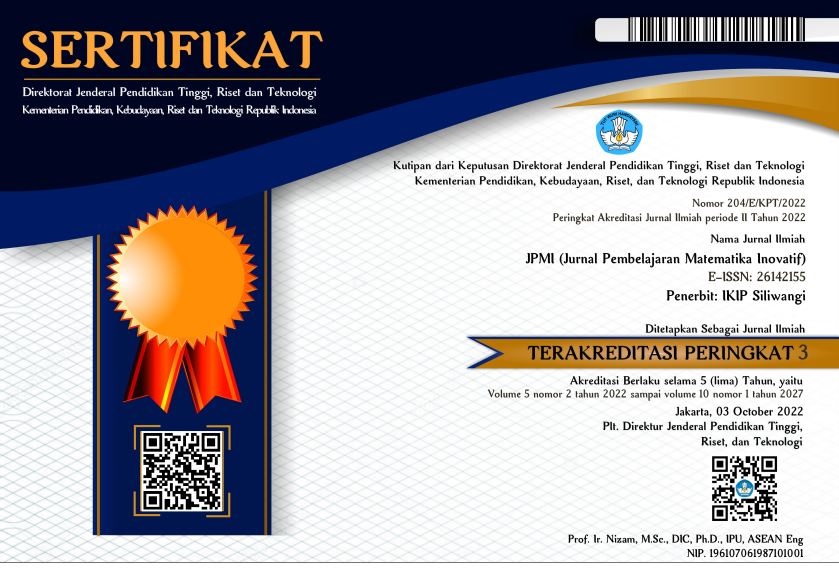Analisis hubungan motivasi belajar dengan prestasi belajar siswa pada materi koordinat kartesius
DOI:
https://doi.org/10.22460/jpmi.v7i6.17102Keywords:
Learning motivation, Learning achievement, Cartesian coordinatAbstract
Learning achievement is influenced by several factors, one of which is student motivation. This research was located in one of the junior high schools in Cimahi City, the purpose of this study is to ascertain whether there is a significant connection between student achievement in mathematics, particularly the Cartesian coordinate material, and learning motivation. This study utilizes a quantitative strategy with correlation analysis. The examining procedure utilized was purposive sampling. The subjects of this study were class VIII students with a total sample of 29 students. This study used test instruments in the form of daily test questions and non-tests in the form of learning motivation questionnaires. Information on learning motivation was gathered through a learning motivation poll while gaining accomplishment information was taken from the consequences of day to day tests at the school. The data were then analyzed using the Pearson correlation test. The results of data processing obtained Sig. (2-tailed) of 0.00 <0.05 which indicates that there is a correlation between motivation and student achievement value Pearson Correlation is 0.630, which shows that there is a positive and strong relationship between learning motivation and students' mathematics learning achievement in Cartesian coordinate material.
References
Andriani, R., & Rasto, R. (2019). Motivasi belajar sebagai determinan hasil belajar siswa. Jurnal Pendidikan Manajemen Perkantoran, 4(1), 80. https://doi.org/10.17509/jpm.v4i1.14958
As’ari, A. R., Tohir, M., Valentino, E., Imron, Z., & Taufiq, I. (2017). Matematika kelas VIII SMP/MTs semester 1 (A. Lukito, A. Mahmudi, Turmudi, Y. Marpaung, Y. Satria, & Widowati (eds.); 2nd ed.). Pusat Kurikulum dan Perbukuan, Balitbang, Kemendikbud.
Budiyani, A., Marlina, R., & Lestari, K. E. (2021). Analisis motivasi belajar siswa terhadap hasil belajar matematika. Jurnal Maju, 8(2), 310–319. https://ejournal.stkipbbm.ac.id/index.php/mtk/article/view/742
Cahyani, A., Listiana, I. D., & Larasati, S. P. D. (2020). Motivasi belajar siswa SMA pada pembelajaran daring di masa pandemi covid-19. IQ (Ilmu Al-Qur’an): Jurnal Pendidikan Islam, 3(1), 123–140. https://doi.org/10.37542/iq.v3i01.57
Dedek Andrian, Astri Wahyuni, Syarul Ramadhan, Fini Rezy Enabela Novilanti, & Zafrullah. (2020). Pengaruh pembelajaran kooperatif tipe STAD terhadap peningkatan hasil belajar, sikap sosial, dan motivasi belajar. Inomatika, 2(1), 65–75. https://doi.org/10.35438/inomatika.v2i1.163
Emor, K. C., Palilingan, R. N., & Wenas, D. R. (2021). Analisis pengaruh suhu dan tekanan udara terhadap daya angkat pesawat di bandara sam ratulangi manado periode 2010-2019 menggunakan metode korelasi pearson product moment. Jurnal Fista: Fisika Dan Terapannya, 2(4), 31–37. https://eurekaunima.com/index.php/fista/article/view/103
Firdaus, D. F. (2020). Pengaruh persepsi siswa tentang kompetensi profesional guru dan kompetensi sosial guru terhadap prestasi belajar siswa pada mata pelajaran ekonomi di SMA N 1 Kuningan. Syntax Idea, 2(3), 24-32. https://www.jurnal.syntax-idea.co.id/index.php/syntax-idea/article/view/153
Gusnawati, Bey, A., & Husnawati. (2019). Pengaruh motivasi belajar terhadap hasil belajar matematika siswa kelas VIII SMP Negeri 1 Sawerigadi. MAJU, 8(2), 48-57. https://uia.e-journal.id/akademika/article/view/1849
Hasbullah, H., & Rahmawati, E. Y. (2015). Pengaruh penerapan metode hypnoteaching terhadap motivasi belajar mahasiswa universitas indraprasta PGRI. Formatif: Jurnal Ilmiah Pendidikan MIPA, 5(1), 83–90. https://doi.org/10.30998/formatif.v5i1.163
Juliya, M., & Herlambang, Y. T. (2021). Analisis problematika pembelajaran daring dan pengaruhnya terhadap motivasi belajar siswa. Genta Mulia, 2(1), 281–294. https://garuda.kemdikbud.go.id/documents/detail/2444494
Lomu, L., & Widodo, S. A. (2018). Pengaruh motivasi belajar dan disiplin belajar terhadap prestasi belajar matematika siswa. Prosiding Seminar Nasional Pendidikan Matematika Etnomatnesia, 3(2), 745–751. https://jurnal.ustjogja.ac.id/index.php/etnomatnesia/article/view/2412
Murjani. (2022). Prosedur Penelitian kuantitatif. Cross-Border, 5(1), 687–713. http://journal.iaisambas.ac.id/index.php/Cross-Border/article/view/1141
Nihayah, E. F. K. (2021). The management analysis of pre-requirements of algebra in. Linear: Jurnal Ilmu Pendidikan, 5(1), 26–39. https://ojs.untika.ac.id/index.php/linear/article/view/127
Nurwahid, M. (2021). Korelasi antara motivasi belajar siswa dalam pembelajaran online dengan hasil belajar matematika di masa pandemi. Jurnal Cendekia : Jurnal Pendidikan Matematika, 5(2), 1127–1137. https://doi.org/10.31004/cendekia.v5i2.596
Sardin, & Nurmita. (2017). Pengaruh kepercayaan diri terhadap prestasi belajar matematika siswa di SMP Negeri 1 Batauga. Jurnal Edukasi, 9(1), 212-220. http://journal.unimma.ac.id/index.php/edukasi/article/view/853
Sarnoto, A. Z., & Suryanto, D. (2017). Pengaruh motivasi belajar dan profesionalisme guru terhadap prestasi siswa. Profesi, 6(2), 44–55. http://researchgate.net
Syafi’i, A., Marfiyanto, T., & Rodiyah, S. K. (2018). Studi tentang prestasi belajar siswa dalam berbagai aspek dan faktor yang mempengaruhi. Jurnal Komunikasi Pendidikan, 2(2), 115-122. https://doi.org/10.32585/jkp.v2i2.114
Waritsman, A. (2020). Hubungan motivasi belajar dengan prestasi belajar matematika siswa. tolis Ilmiah; Jurnal Penelitian, 1(2), 124–129. https://ojs.umada.ac.id/index.php/tolis_ilmiah/article/view/91
Wijayani, I., Haenilah, E. Y., & Sugiman. (2017). Hubungan motivasi belajar dengan prestasi belajar siswa kelas V. Jurnal Pedagogi, 6(6), 3–7. http://jurnal.fkip.unila.ac.id/index.php/pgsd/article/view/13942.
Downloads
Published
Issue
Section
License
Copyright (c) 2025 JPMI (Jurnal Pembelajaran Matematika Inovatif)

This work is licensed under a Creative Commons Attribution-ShareAlike 4.0 International License.
The author is responsible for acquiring the permission(s) to reproduce any copyrighted figures, tables, data, or text that are being used in the submitted paper. Authors should note that text quotations of more than 250 words from a published or copyrighted work will require grant of permission from the original publisher to reprint. The written permission letter(s) must be submitted together with the manuscript.
















